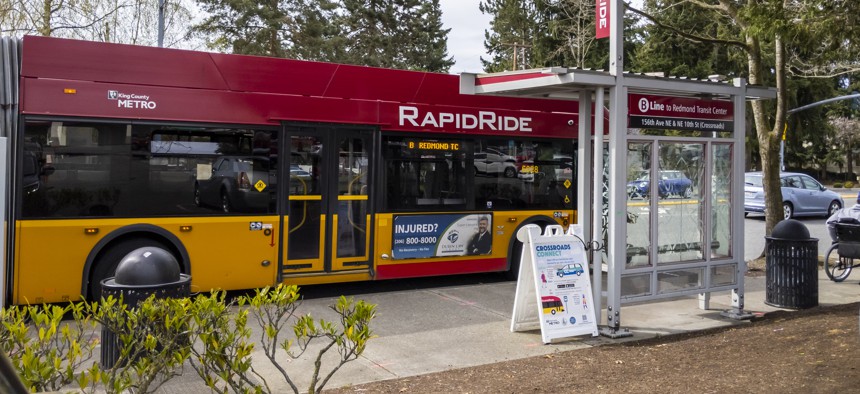Transportation Agencies Grapple With Lasting Effects of Telework

Redmond, Washington, April 2021: A Rapid Ride metro bus stopping at a bus stop. istockphoto.com/Colleen Michaels
Many workers are not going back to offices full time and governments need to figure out how to adjust. “When we are not collecting gas taxes and ferry fares, our budget is hurting," one state transportation chief said during a Route Fifty event.
Millions of people shifted to remote work when the coronavirus crisis began last March, and many of those workers are not returning to office buildings full time. Governments must adjust to new commuting patterns, and data collection and analysis can effectively provide answers, transportation officials said during a recent Route Fifty virtual event.
Roger Millar, secretary of transportation for Washington, said that commuting patterns have not returned to pre-pandemic levels in his state. “The morning commute hasn’t come back but the nighttime commute has,” he said. “Midday [travel] is up. That reflects the extent that people are teleworking.”
Millar said his agency doesn’t have enough data on telework yet to make last changings, but that Washington is “advocating for a values-based, data-informed approach.”
The pandemic took commuters off highways, local roads and mass transit, which has taken a significant toll on Washington’s transportation revenues, Millar said. He noted that highway traffic is down 8%, toll revenues are down 33%, and intercity passenger rail and ferry ridership are down 67% and 35%, respectively.
“Eighty-eight percent of my budget is raised in the state of Washington,” he said. “When we are not collecting gas taxes and ferry fares, our budget is hurting.”
Garrett Eucalitto, deputy commissioner Connecticut’s Department of Transportation, said his state, while much smaller, has had similar experiences. He said Connecticut had a “precipitous drop” in commuter rail ridership, “greater than 95%.” He added that while statewide bus ridership never dipped below 50%, it still is down about 30% from pre-pandemic levels.
But, Eucalitto said, “buses were a critical lifeline." They proved to be so essential during the pandemic that his agency convinced the state legislature to increase funding to expand bus service.
“We were able to show that through data,” he added.
Going forward, Millar said, transportation agencies have to “parse out the effect of telework. … What do we do in the middays? How do we support telework as a lifestyle choice?”
“When it comes to transit, we are still figuring it out,” Eucalitto said, noting that many South Connecticut residents commute to New York City. “A lot of businesses are not having people coming back to offices full time but we are hearing some are going to come back after Labor Day,” he added. “We are waiting to see what happens.”
Nevertheless, based on pandemic data, Connecticut is increasing bus service and hours starting in August in New Haven. “We recognize the importance of running services for currently underserved areas,” the official said.
Technology is Key
Eucalitto said Connecticut did not halt its technology projects since the pandemic began, and has viewed this time as an opportunity to advance them.
Connecticut’s rail system runs along the state’s coast, and riders have complained about connectivity on trains. He said his agency is exploring improvements, including partnering with a telecommunications firm to install 5G along the right of way or getting satellite Wi-Fi installed on the trains.
“The most exciting part is that the legislature and budget office [see] the importance of having data,” he said, noting the agency hired data analysts for the first time during the last year. “We need to be able to use the data to make informed decisions. That will help us identify what technologies we want to use next.”
Finally, transportation departments must “take this telework transformation and make it real as we get into a more hybrid environment”—not just for residents but for government workers, Millard said. He noted that 50% of his agency’s staff has worked from home since the start of the pandemic, and that 75% of those employees want to telework three days a week or more going forward.
But supervisors are resisting. “I’m telling our managers to get used to it,” Millard said. “If you don’t facilitate what people want in balancing their work and their life they are going to go somewhere else.”
“Technology makes it possible,” he added. “We had the technology before; we were forced to use it and found we liked it and built on that.”
Jean Dimeo is managing editor of Route Fifty.
NEXT STORY: High-Tide Flood Risk is Accelerating, Putting Coastal Economies at Risk





